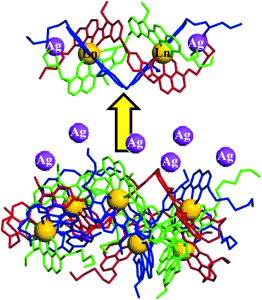Publication 79
- “Silver Baits for The "Miraculous Draught" of Amphiphilic Lanthanide Helicates”
E. Terazzi, L. Guénée, J. Varin, B. Bocquet, J.-F. Lemonnier, D. Emery, J. Mareda, C. Piguet
Chem. Eur. J. 2011, 17, 184-195.

The axial connection of flexible thioalkyls chains of variable length (n=1-12) within the segmental bis-tridentate 2-benzimidazole-8-hydroxyquinoline ligands [L12Cn-2 H]2- provides amphiphilic receptors designed for the synthesis of neutral dinuclear lanthanides helicates. However, the stoichiometric mixing of metals and ligands in basic media only yields intricate mixtures of poorly soluble aggregates. The addition of AgI in solution restores classical helicate architectures for n=3, with the quantitative formation of the discrete D3-symmetrical [Ln2Ag2(L12C3-2 H)3]2+ complexes at millimolar concentration (Ln=La, Eu, Lu). The X-ray crystal structure supports the formation of [La2Ag2(L12C3-2 H)3][OTf]2, which exists in the solid state as infinite linear polymers bridged by S-Ag-S bonds. In contrast, molecular dynamics (MD) simulations in the gas phase and in solution confirm the experimental diffusion measurements, which imply the formation of discrete molecular entities in these media, in which the sulfur atoms of each lipophilic ligand are rapidly exchanged within the AgI coordination sphere. Turned as a predictive tool, MD suggests that this AgI templating effect is efficient only for n=1-3, while for n>3 very loose interactions occur between AgI and the thioalkyl residues. The subsequent experimental demonstration that only 25 % of the total ligand speciation contributes to the formation of [Ln2Ag2(L12C12-2 H)3]2+ in solution puts the bases for a rational approach for the design of amphiphilic helical complexes with predetermined molecular interfaces.
DOI : 10.1002/chem.201002771
archive ouverte unige:13185
